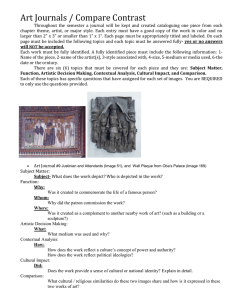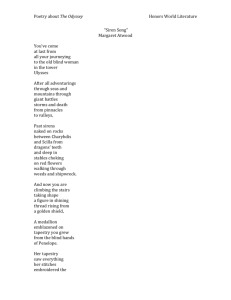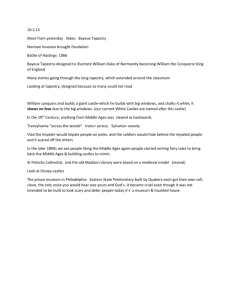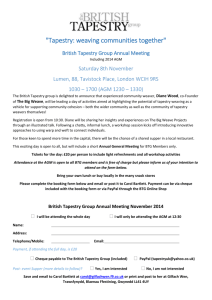Cultural Phenomenon of Aesthetic Minimalism in Mediterranean Journal of Social Sciences
advertisement
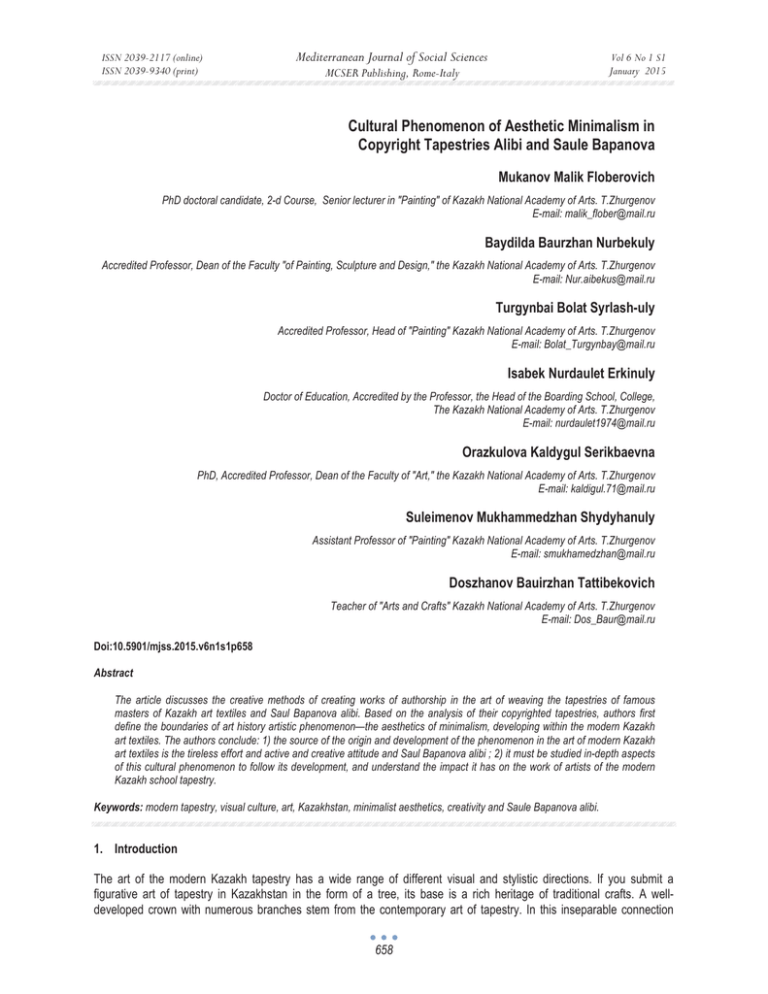
ISSN 2039-2117 (online) ISSN 2039-9340 (print) Mediterranean Journal of Social Sciences Vol 6 No 1 S1 January 2015 MCSER Publishing, Rome-Italy Cultural Phenomenon of Aesthetic Minimalism in Copyright Tapestries Alibi and Saule Bapanova Mukanov Malik Floberovich PhD doctoral candidate, 2-d Course, Senior lecturer in "Painting" of Kazakh National Academy of Arts. T.Zhurgenov E-mail: malik_flober@mail.ru Baydilda Baurzhan Nurbekuly Accredited Professor, Dean of the Faculty "of Painting, Sculpture and Design," the Kazakh National Academy of Arts. T.Zhurgenov E-mail: Nur.aibekus@mail.ru Turgynbai Bolat Syrlash-uly Accredited Professor, Head of "Painting" Kazakh National Academy of Arts. T.Zhurgenov E-mail: Bolat_Turgynbay@mail.ru Isabek Nurdaulet Erkinuly Doctor of Education, Accredited by the Professor, the Head of the Boarding School, College, The Kazakh National Academy of Arts. T.Zhurgenov E-mail: nurdaulet1974@mail.ru Orazkulova Kaldygul Serikbaevna PhD, Accredited Professor, Dean of the Faculty of "Art," the Kazakh National Academy of Arts. T.Zhurgenov E-mail: kaldigul.71@mail.ru Suleimenov Mukhammedzhan Shydyhanuly Assistant Professor of "Painting" Kazakh National Academy of Arts. T.Zhurgenov E-mail: smukhamedzhan@mail.ru Doszhanov Bauirzhan Tattibekovich Teacher of "Arts and Crafts" Kazakh National Academy of Arts. T.Zhurgenov E-mail: Dos_Baur@mail.ru Doi:10.5901/mjss.2015.v6n1s1p658 Abstract The article discusses the creative methods of creating works of authorship in the art of weaving the tapestries of famous masters of Kazakh art textiles and Saul Bapanova alibi. Based on the analysis of their copyrighted tapestries, authors first define the boundaries of art history artistic phenomenon—the aesthetics of minimalism, developing within the modern Kazakh art textiles. The authors conclude: 1) the source of the origin and development of the phenomenon in the art of modern Kazakh art textiles is the tireless effort and active and creative attitude and Saul Bapanova alibi ; 2) it must be studied in-depth aspects of this cultural phenomenon to follow its development, and understand the impact it has on the work of artists of the modern Kazakh school tapestry. Keywords: modern tapestry, visual culture, art, Kazakhstan, minimalist aesthetics, creativity and Saule Bapanova alibi. 1. Introduction The art of the modern Kazakh tapestry has a wide range of different visual and stylistic directions. If you submit a figurative art of tapestry in Kazakhstan in the form of a tree, its base is a rich heritage of traditional crafts. A welldeveloped crown with numerous branches stem from the contemporary art of tapestry. In this inseparable connection 658 ISSN 2039-2117 (online) ISSN 2039-9340 (print) Mediterranean Journal of Social Sciences MCSER Publishing, Rome-Italy Vol 6 No 1 S1 January 2015 between tradition and modernity, thanks to the tireless work of artists and masters of textiles, born and develops an interesting cultural phenomenon. Unfortunately, it has not attracted the attention of people who study contemporary art in Kazakhstan with the scientific and practical point of view. The analysis of art criticism and typological analysis of the aforementioned artistic phenomenon as necessary for an understanding of its role in the art of modern Kazakh tapestry, and for the further development in the context of operational applications. The first step is to identify the cultural and artistic typology of the phenomenon. Give him a specific and accurate name, based on certain aesthetic and artistic categories, to develop a classification term, within which will be further considered works of authorship, in the technique of tapestry and art related to this phenomenon. So what are the criteria we attract to determine the conceptual apparatus under consideration artistic phenomenon? Primarily we use the term "minimalism" because even on a visual level, it is pronounced and characteristic of such tapestries. [1] Their composition solution and iconic series of very concise and sometimes expressed in two or three found precisely and intelligently align the symbols. Sometimes, it is just a decorative stain constituting found any artistic image. The second criterion, proposed by the authors of the report to identify the conceptual apparatus is the concept of "aesthetics." Complete the same phrase, and characterize artistic phenomenon before us is "aesthetics of minimalism." More precisely copyrighted tapestries of modern Kazakh art created in the aesthetics of minimalism. There may be a reasonable question: why the term "aesthetics" and not, for example, "concept?" After all, "the concept of minimalism" or "copyright tapestries” created the concept of minimalism and reflects the essence of the artistic phenomenon. But in this case, applying this concept as a conceptual device, there is a danger to drive the artistic phenomenon in the narrow confines of genre art form and not treat it as a cultural phenomenon. Then, the concept of "concept" still falls closer to the mathematically - engineering and design activities of man, than to the fine arts. And, as an artistic phenomenon in question is not only an iconic character, but also represents a cultural stratum in contemporary art Kazakh tapestry, then apply to it a broad category that characterizes human activity - aesthetics [2]. 2. Research and Results In the era of its inception as an art form, under the dominating influence of pictorial style of European portrait miniatures, prevailed in the tapestry decorative fine start. In the future, the development of the art of tapestry or tapestry is expressed in the stylistic transition to pictorial and decorative realism.[3] Against the background of this process in the art of tapestry, and specifically in the art of textile Kazakhstan born cultural phenomena. One of them is the copyright of tapestries in the aesthetics of minimalism. To the emergence and development of this class of works of art cannot be treated simply as a fact or datum. It is necessary to consider this phenomenon and analyze its origins, forms, and means of artistic expression, as well as individual authors, artists involved in the birth and formation. This research approach will enable understanding artists and art further ways of development. Selection of the many artistic trends that could be used as a foundation for further development is very important for any kind of modern art. This creates not only a favorable situation for more in-depth study of art history challenges ahead, and, above all, allows us to rethink and revise existing aesthetic canons. 3. Discussion In its heyday, the art of tapestry, tapestries and more precisely characterized by a rich palette of beautiful and pronounced dominance of figurative -realistic images, as compositionally forming bases. Pictorial language tapestry stylistically trying to approach the art of painting. [4] In the future, high labor intensity and high cost of production due to the incredible, artistic weaving leads to deadlock. By the early twentieth century, tapestries as works of art are almost not created at all. The situation changes radically in the 40 years of the twentieth century, when the art of tapestry comes French artist Jean Lurçat. His innovation becomes simplification weaving technology, which significantly accelerates the process of creating the tapestry. He also introduces the technology of manufacturing of tapestries digital tinted cardboard, in which each color scheme matches your serial number. The number of colors involved in color palette tapestry, it limits the range of 40 to callers. But most importantly Lurcat refuses painterly style images and revives decorative and symbolic beginning that introduces the art of tapestry in the framework of a new aesthetic, reverting to a decorative tapestry system image with the involvement of national-cultural imaginative and symbolic elements. During this period, the "new flowering " tapestry, based on ethnographic motifs cleared of graphic-pictorial qualities, becomes a completely different pictorial plane. This new aesthetic of art tapestry receives the widest distribution 659 ISSN 2039-2117 (online) ISSN 2039-9340 (print) Mediterranean Journal of Social Sciences MCSER Publishing, Rome-Italy Vol 6 No 1 S1 January 2015 in Europe and the USSR. Nowadays, most of the works of art made in the technique of tapestry can be attributed to the aesthetic system created by Jean Lurcat. Interested in his thoughts on the role of the artist: "There is no professional art,” there is no difference in the nature of the artist and the artisan. The artist, not that other, as inspired by the craftsman, and only from some subtle divine instances depends, will the work of the artisan work of art"[5]. Based on her master art weaving, try not to look at his work a new, modern aesthetic form. In such a tapestry, indeed archaic, hidden outright speculation of the technology of hand weaving. That is, if the author's work is woven by hand, it is already, of course, is a work of art. Anticipating this, Lurcat persistently emphasized: "It is not the technology, the technology is only a tool, not a starting point"[6]. Essentially, carpet weaving tradition from the Middle Ages, despite the evolution of this craft. Thus, many specialists of textile working in the art of hand weaving, will not be able to overcome the level of artisan if their life and work will not be devoted to a comprehensive commitment. It includes both personal cognitive growth and the relentless search for new compositional techniques and in the formulation and solution of problems of highly visual and, no matter how corny it sounds tremendous patience in daily work. This topic is always relevant, and especially in these days when young artists want to achieve creative results and public recognition, not applying to this worthy effort and patience. In the fine art work of the artist of Kazakhstan, consider and adopt the pictorial aesthetics Jean Lurcat and embody its main tendencies in his works in the art of tapestry. This Kurasbek Tynybekov. Here is what we read in the article Shklyaeva S. "Development of Applied Art of Kazakhstan Soviet era " (1920-1991 th years): "The role of K. Tynybekova in the applied arts of Kazakhstan 1970s in fact more important than the artist who discovered." The first page can be called and the first artist in his works to the language of semiotics, typical of post-structuralism, in which important concepts iconic signs. The short career of an artist (1970-1980 gg.) outlined the main points of intensive search of synthesis of folk traditions and innovations in the Fine textiles decades. For the first time in the product, it was important "contextual knowledge" signs, and reading the works itself was akin annotating text"[7]. His unfortunately short life, but very fruitful creative activity he laid the foundations of the national school of art tapestry. And left a legacy not only as works of art, but also a whole galaxy of disciples to continue his career in our days. Creative results of a new generation of textile artists eventually formed a new aesthetic form. This was reflected in the art of monumental and decorative and architectural tapestry -being, felt, and in the objects and concepts of ethnographic design—the author's clothes, installations, and performances. Most importantly they were able to bring to the fine art of Kazakhstan new symbolic categories based on the images of traditional culture [8]. Now it is the time to mention the artists whose works of fine art authors were proclaimed a cultural phenomenon. It is known in Kazakhstan masters of artistic textiles Alibay and Saul Bapanova. Their works, in the technique of weaving the tapestry have a pronounced artistic style. Much of the composition of tapestries mainly constructed using exactly the found images and symbols using minimum, laconically Fine-tuned vehicles. Master the art of textiles, based on the set for a highly tasks miss the experience of traditional folk art through the mind of a professional artist of the twentieth century. They do not just use traditional motifs in contemporary tapestry, and experiencing their modern. Alibay and Saul Bapanova inspired from the inexhaustible source of traditional ethnographic culture of the Kazakh people. You do not blindly copy them and mechanically transfer of these individual elements and images in their composition, and their active creative rethinking. Thus, the proximity of artists to the national tradition has become the foundation of their work, and the European tradition of one of its elements. Every great artist is primarily an innovator. It was he, in a new way, as no one before him, expressed his understanding of the mystery, beauty and harmony of the world, its position on the relation of forces in the struggle between good and evil, their understanding of the inner essence of the nature of human relationships to each other and to the Creator. But true innovation is impossible without traditions. She, like the "Ariadne's thread" does not get lost in a maze; the creator is multifaceted, constantly rebuilt and changing world. And as a consequence, innovation is a new experienced, intelligent and embodied tradition. This innovative tendency to generalization and symbolization laid from the beginning of the creative life companions and spouses alibi and Saul Bapanova. It is achieved through recourse to such an expressive art medium, as an allegory, metaphor and symbol. In each of their work is felt inner significance, all of this creates a great interest of the audience to their creativity. One of the most characteristic features of the work of artists is the ability to convey complex concept through a simple (and also not simple) way of attracting a simple and concise visual tools. Take, for example, a tapestry entitled "The Universe,” 150h160 cm., 1998 Name of the work itself carries so capacious sense that not everyone will take up artistic solution of such a comprehensive way. 660 ISSN 2039-2117 (online) ISSN 2039-9340 (print) Mediterranean Journal of Social Sciences MCSER Publishing, Rome-Italy Vol 6 No 1 S1 January 2015 Tapestry "The Universe" (Univerce), 150ɯ160 ɫɦ., 1998 ɝ. Bapanova also take drawing spirals initial curl which have centered almost equilateral rectangular canvas. Then, alternately thickening, then thinning, and sometimes even briefly interrupting the line of the spiral movement to develop it as long as it does not go beyond the tapestry. As a result, the viewer sees a double helix illustration image: spiral and rose itself, if you look at her full-blown bud downwards. Taken together and combined into a single unit, the two imagesymbol image inspired by the artists of the universe. From the point of view is shaped face two fundamental principles of being: a spiral, as the basis of world order and the spiral as the private life of the flower (the individual). It turns out that man's destiny and the fate of the universe are indissolubly united. What we both have a certain development program (spiral), and that all the world is permeated by a single start. It should be mentioned that the symbol—a sign of a special talking about the ambiguity of the image. Visible image of a subject and the hidden depths of meaning in the structure act as a symbol of the two poles, one without the other is unthinkable. After all, the meaning of lose your way out clearly, and the image is the meaning disintegrates into its components. So, at least, I want to bring the philosophical underpinnings of this remarkable depth and simplicity of operation. In her unforgettable image of the world mountain artists take a crown, because in the World grief for them is important, not the mountain itself from bottom to top, and the fact that she is holding the Bull (the image is not as simple as the actual world mountain ). At the Bull, in turn, is also a very important mission; he did not support their horns anything, and part of the universe, the very night light - shining sickle newborn months. Muted pastel colors are different, corresponding to a noble austerity and deepening of the image itself. This brings to mind the distant half-forgotten details that in Tengrian culture ox -like creature with a cold breath, always personified the night, which means friendly and correlated with nocturnal luminary - moon. And again, through a combination of minimal elements artists create for himself and for the audience creative image of time - bull on top of the mountain with the moon on the horns - a torch, universal beacon, illuminating the whole sublunary world. That's right, a representative of domestic cattle, by the will of the artist receives new figurative birth, appears in a crucial status in its original, archetypal form. ɝɨɛɟɥɟɧ «Mountain of the world - II», 183ɯ163 ɫɦ., 2007 ɝ. 661 ISSN 2039-2117 (online) ISSN 2039-9340 (print) Mediterranean Journal of Social Sciences MCSER Publishing, Rome-Italy Vol 6 No 1 S1 January 2015 The fact that the ancient mythology of different nations has brought to our time certain uniform in structure and content of the image - archetypes : archetypes, originals, "images of the collective unconscious" (Carl Jung), i.e., those ancient symbols of universal primary images underlying myths, tales and legends. According to Jung, archetypes are the structural elements of the human psyche, which are hidden in the collective unconscious common to all mankind. They are inherited, just as the human body is inherited, and emerge in consciousness upon awakening the creative activity of the individual. It follows that the archetype—a presence of the past in the present, universal base images, passing from generation to generation. In Turkic mythology such images are previously mentioned the name of the Supreme God Tengri World Mountain, the Tree of Life, Temir Kazyk, Germain Ana, Jer- Uyyk and many beautiful ancient imagery demanded in the art of our time as never before. In a completely different vein appears tapestry "Silence” 170h145 cm. 1997. It can be called impressionistic minimalism, seeing through the eyes of the artist painting of nature, captured by a weave wool yarn, leaving a surprisingly tranquil sense of peace and contemplation. Recall the paintings of the famous Chinese artist Guo Xi. The same detachment from the world of the human individual and the simultaneous merger with him. A composition is utterly simple: for thin fragile trunks of deciduous trees can be seen from the surface of the lake is weakly reflected in its clouds, the contours of the surrounding mountains, sparse rows of coastal scrub, by the mountains, bushes and pieces of the sky, barely breaks through the crown of leaves in the foreground. All this beauty quietest touched a light haze of fog. The painting is executed in light gray, pale lilac and lavender pastel colors with small patches of dark tones of shrubs and trees in the foreground and the background. In the product there is light somewhere brighter somewhere muffled. He, however, comprehends all visible space, and you may say, takes on a major role in creating the overall atmosphere and mood of the witch of the landscape, this wonderfully peaceful scene of nature. ɝɨɛɟɥɟɧ «Ɍɢɲɢɧɚ», («Silence») 170ɯ145 ɫɦ., 1997 ɝ. It should be noted that the motive of contemplation, sadness, and quiet is a significant emotional component of almost all the works of artists. His cross-cutting theme runs through all the creativity and Saul Bapanova alibi. The same laconic, one could even say doling visual tools to attract Bapanova decision artistic image "Bearer" in the same tapestry («Flagman») 180h156 cm in 2010. 662 ISSN 2039-2117 (online) ISSN 2039-9340 (print) Mediterranean Journal of Social Sciences MCSER Publishing, Rome-Italy Vol 6 No 1 S1 January 2015 ɝɨɛɟɥɟɧ «Flagman», 180ɯ156 ɫɦ., 2010 ɝ. On the whole format of the vertical rectangle woven fabric figure of the rider. The stylized image of a standard bearer on horseback great elegance silhouette creative solutions found. He holds the flagstaff, which leads diagonally up over the edge of the composition itself cloth flag. Also, if is not placed within the picture plane, the head and tail of a horse go over the edge of the tapestry. This artistic technique makroeffekta when the author of the work the viewer closer to the image artificially achieved momentary etched. As if the standard-bearer inspired us with his presence, the next moment has to go to another, it is known to the measurement in order to continue its mission. By way of a standard bearer in the fine arts artists turn quite often as a military- applied activity is not just a man carrying a flag. Needless banner, battle standard, its symbol represents the cohesive spirit of people united by one idea and purpose, and often opposing any force. There comes to mind a scene from a masterpiece of world cinema, "Seven Samurai " by Akira Kurosawa, 1954, when the heroes of the story are preparing to defend the village from the attack of thieves, robbers. In the central hut, which housed the samurai, one of them by hand sew banner. One of the characters - Chicoutimi (peasant's son, who pretended to be a samurai, was exposed, but still were among seven soldiers - defenders of the village) sets sewing simple question: What are you doing ? To which he, knowing that the demand does not belong to the estate of soldiers, calmly responds: “This banner. It raises the morale! After a battle, when you see the waving flag, do you remember the name of what you are fighting and dying” [9]. Since ancient times, it was considered a great shame if in the heat of battle the battle flag of the hands of the enemy. Therefore, to carry the banner into battle trusted only morally, spiritually, and physically strong soldiers who represents an example of courage, dedication and persistence. Since the same qualities necessary for the person on the creative path, the standard-bearer appears to us in a completely different imaginative dimension. It is no secret that truly change the world and lead it to progress no merchants and bankers, and people work—artists, poets, architects, inventors and designers. Like bearers, they go to the very forefront of the cultural development of human society. And if the creators literally do not carry the flag in his hands, his spirit must always be present within them, inspiring walking trail. Perfect in fine style and capacious on semantic symbolic content copyright decision artistic image - bearer, made in the aesthetics of minimalism. The essence of the creative method and content of alibi and Saul Bapanova - is not just a story about something in the form of decorative and figurative language. This, above all, is the picture of the world of philosophical and symbolic plan that reflects the problems of society, historical and mythical past, the fate of man and nature [10]. At the heart of their work is as sensual and analytical method of artistic thinking. A process of artistic development of artists comes from the sensory perception of the world to its analysis. Thus, each artist’s pictorial motif has its symbolic value and is the impetus for the emergence of a number of associations. They, in turn, develop a deeply meaningful artistic images. And here, in the words of Le Corbusier : "... take effect mathematical laws of our mind, enjoying the spectacle, we simultaneously find in it an expression of the laws of the universe." [11] Of course, when a creative artist creates a work of art, it expresses not just any author's vision of one of the facets of human existence. It is primarily a process of dialogue with the audience. Turning to his consciousness, the artist operates compositional and stylistic figurative elements, creating his own unique artistic language of the author. It arises 663 ISSN 2039-2117 (online) ISSN 2039-9340 (print) Mediterranean Journal of Social Sciences MCSER Publishing, Rome-Italy Vol 6 No 1 S1 January 2015 "... of the urgent need to communicate with others." [12] In this way the relentless search for and development of new figurative and stylistic forms of visual language of the artist lies in wait for an interesting paradox. It lies in the fact that in some moment contemplating the viewer cannot understand and do not take innovative figurative pictorial findings. It is quite a paradox, because the modern viewer, unfortunately, is often limited in art education and consequently in the perception of the subject of the author's visual culture. He just does not understand the visual and symbolic language of the artist. And "... for another epithet, which we treat indifferently, writes Academician Veselovskii, lies far historical and psychological perspective, the accumulation of metaphors, similes, and distractions, the whole history of taste and style in its evolution - from idea and useful desired to highlight the notion of beauty..."[13] In such a situation, it becomes important author's position, as at all times, for the artists perception problem in a practical sense, stands as a problem relationship with the audience. People live in the already created for them an environment where constantly enter new and new components. Nowadays, of course most of them bears a design functions than fiction. [14] A new art components that do not have a realistic style of presentation, sometimes perceived with difficulty or gradually. Despite this, it is important to search for the artist, and not just to create something new, but also realize that this is a new need as life itself. 4. Conclusion In conclusion, I want to say that the cultural phenomenon of aesthetic minimalism emerged in contemporary art Kazakh tapestry through creative activities and Saul Bapanova alibi and their tireless work in the artistic search for innovative ideas, concepts and images. In this approach the masters of artistic textiles to the business, you can create highly aesthetic works of art filled with the content of the national idea as part of the modern culture of Kazakhstan. Such a culture, of which the Italian cultural studies and art historian George C. Argan wrote: "Modern culture must be able to include in its historical culture value memory, the presence of his own past as a forecast and project their own future." [15] 5. Acknowledgements The authors express special thanks to Dr., Associate Professor WAC - Galimzhanovoy Asiya Saidovna for active assistance in the preparation of the scientific and structural apparatus and for his contribution to the development of scientific manuscripts. References Nedostupov R. A. Development of the concept of minimalism in the work of contemporary international designers and architects. Proceedings of the universities. Architect. 2009. ʋ 22. http://archvuz.ru/number/200922/k29 Bychkov VV Aesthetics. Moscow: Gardariki. 2007. 350 page. Joubert Fabienne, Amaury Lefebure, Pascal-Francois Bertrand. Histoirede laTapisserie. En Europe, du Moyen Age a nosjours. Flammarion: Paris. 1995. 384 page. Savickaya VI Transformation trellis. Moscow: Galart. 1995. 86 page. Kiselev OI Renaissance tapestry art in France in the first half of the twentieth century and the creation of Jean Lurcat. Dis. cand. Art History:17.00.05, Saint Petersburg.1995. 125 page. L. Batkin Life and Works of Jean Lurcat. Soviet art history, ʋ 2, Moscow: Soviet Artist 1978, page. 94 Shklyaeva SA - In:, Art History of Kazakhstan, 3 vol., Almaty: Oner, 2011 ɝ,. – Ɍɨɦ 1.: Arts and Crafts, - page. 96 Gachev GD National images of the world. Eurasia - space nomad, farmer and mountaineer. Moscow: DIDIK INSTITUT.1999. 174 page. Donald Richie. The Films of Akira Kurosawa. — Third edition. Berkley, Los Angeles, London: University of California Press, 1998. 85 page. Berger LG spatial image of the world (the paradigm of knowledge) in the structure of the artistic style. Problems of Philosophy.ʋ 4. 1994. – page 32 -37. Le Corbusier. As Emperiroles a termeszetesrol / Arspoeticak a XX szazadbol, Gondolat: Budapest. 1982. - 236 page. K. Marx and F. Engels, About art - Ɍ.1. Moscow. 1957. - page 145 Veselovskii AN historical poetics. Moscow: Higher School. 1989. – page 173 Lisovets IM design and popular culture. From the mass culture to culture individual worlds: a new paradigm of civilization. Moscow. Ideapress. 1998. 400 page Argan G. K. Storiadellarte com storiadellacitta. Roma: Editori Ruiniti. 1983. – 68 page 664 ISSN 2039-2117 (online) ISSN 2039-9340 (print) Mediterranean Journal of Social Sciences MCSER Publishing, Rome-Italy 665 Vol 6 No 1 S1 January 2015

